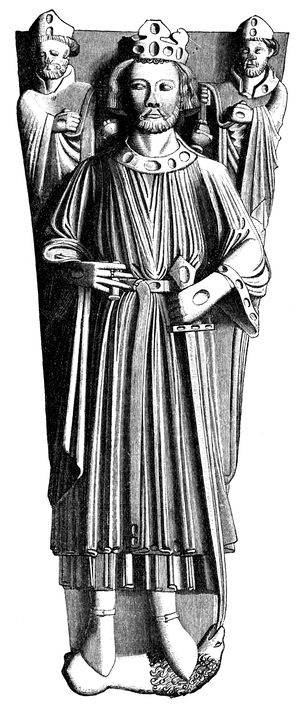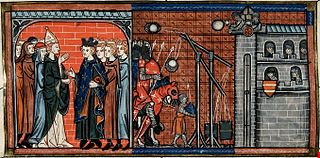
The Battle of Bouvines was fought on 27 July 1214 near the town of Bouvines in the County of Flanders. It was the concluding battle of the Anglo-French War of 1213–1214. Although estimates on the number of troops vary considerably among modern historians, at Bouvines, a French army commanded by King Philip Augustus routed a larger Allied army led by Holy Roman Emperor Otto IV in one of the rare pitched battles of the High Middle Ages and one of the most decisive medieval engagements.

John was King of England from 1199 until his death. He lost the Duchy of Normandy and most of his other French lands to King Philip II of France, resulting in the collapse of the Angevin Empire and contributing to the subsequent growth in power of the French Capetian dynasty during the 13th century. The baronial revolt at the end of John's reign led to the sealing of Magna Carta, a document considered an early step in the evolution of the constitution of the United Kingdom.

Otto IV was the Holy Roman Emperor from 1209 until his death in 1218.

Philip II, byname Philip Augustus, was King of France from 1180 to 1223. His predecessors had been known as kings of the Franks, but from 1190 onward, Philip became the first French monarch to style himself "King of France". The son of King Louis VII and his third wife, Adela of Champagne, he was originally nicknamed Dieudonné (God-given) because he was a first son and born late in his father's life. Philip was given the epithet "Augustus" by the chronicler Rigord for having extended the crown lands of France so remarkably.

Year 1214 (MCCXIV) was a common year starting on Wednesday of the Julian calendar, the 1214th year of the Common Era (CE) and Anno Domini (AD) designations, the 214th year of the 2nd millennium, the 14th year of the 13th century, and the 5th year of the 1210s decade.
The Duchy of Anjou was a French province straddling the lower Loire. Its capital was Angers, and its area was roughly co-extensive with the diocese of Angers. Anjou was bordered by Brittany to the west, Maine to the north, Touraine to the east and Poitou to the south. The adjectival form is Angevin, and inhabitants of Anjou are known as Angevins. In 1482, the duchy became part of the Kingdom of France and then remained a province of the Kingdom under the name of the Duchy of Anjou. After the decree dividing France into departments in 1790, the province was disestablished and split into six new départements: Deux-Sèvres, Indre-et-Loire, Loire-Atlantique, Maine-et-Loire, Sarthe and Vienne.

Louis VIII, nicknamed The Lion, was King of France from 1223 to 1226. As prince, he invaded England on 21 May 1216 and was excommunicated by a papal legate on 29 May 1216. On 2 June 1216, Louis was proclaimed "King of England" by rebellious barons in London, though never crowned. He soon seized half the English kingdom but was eventually defeated by the English and after the Treaty of Lambeth, was paid 10,000 marks, pledged never to invade England again, and was absolved of his excommunication.

Peter I, also known as Peter Mauclerc, was Duke of Brittany jure uxoris from 1213 to 1221, and regent of the duchy for his minor son John I from 1221 to 1237. As duke he was also 1st Earl of Richmond from 1218 to 1235.

The term Angevin Empire describes the possessions of the House of Plantagenet during the 12th and 13th centuries, when they ruled over an area covering roughly half of France, all of England, and parts of Ireland and Wales, and had further influence over much of the remaining British Isles. It may be described as an early example of a composite monarchy. The empire was established by Henry II of England, who succeeded his father Geoffrey Plantagenet as Duke of Normandy and Count of Anjou. Henry married Eleanor of Aquitaine in 1152, becoming her royal consort, and inherited his mother Empress Matilda's claim to the English throne, succeeding his rival Stephen in 1154. Although their title of highest rank came from the Kingdom of England, the Plantagenets held court primarily on the continent at Angers in Anjou, and at Chinon in Touraine.
Andre de Chauvigny (1150–1202) was a Poitevin knight in the service of Richard I of England. He was the second son of Pierre-Hélie of Chauvigny and Haois of Châtellerault. Haois was the great-aunt of King Richard making Andrew and Richard second cousins.

The Saintonge War was a feudal dynastic conflict that occurred between 1242 and 1243. It opposed Capetian forces supportive of King Louis IX's brother Alphonse, Count of Poitiers and those of Hugh X of Lusignan, Raymond VII of Toulouse and Henry III of England. The last hoped to regain the Angevin possessions lost during his father's reign. Saintonge is the region around Saintes in the centre-west of France and is the place where most of fighting occurred.
William des Roches was a French knight and crusader who acted as Seneschal of Anjou, of Maine and of Touraine. After serving the Angevin kings of England, in 1202 he changed his loyalty to King Philip II of France and became a leading member of his government.
A seneschal was an officer of an aristocratic household assigned to manage the domestic affairs of the lord. During the course of the twelfth century, the seneschalship also became an office of military command.

Gétigné is a commune in the department of Loire-Atlantique in the Pays de la Loire region in western France.

The siege of La Rochelle of 1224 was the decisive engagement in the campaign between the Capetians and the Plantagenets for control of Poitou. French royal forces commanded by Capetian king Louis VIII laid siege to the strategic port of La Rochelle and its garrison of Poitevin and English soldiers commanded by Savari de Mauléon. The port had long been a staging ground for Plantagenet efforts to regain their continental lands lost to the French crown since 1203. The siege lasted from July to August 1224, and resulted in La Rochelle's citizens surrendering the city to Louis after the failure of English relief to emerge. The siege of La Rochelle was the crowning event of the Capetian conquest of Poitou from the Plantagenets. With Poitou in Capetian hands, only Gascony remained under Plantagenet rule on the continent.

The Normandy Campaigns were wars in Normandy from 1202 to 1204. The Kingdom of England fought the Kingdom of France as well as fighting off rebellions from nobles. Philip II of France conquered the Anglo-Angevin territories in Normandy, resulting in the Siege of Château Gaillard. The Normandy Campaigns ended in a victory for France when the Anglo-Angevin territory was greatly diminished.

The Capetian–Plantagenet rivalry was a series of conflicts and disputes that covered a period of 100 years (1159–1259) during which the House of Capet, rulers of the Kingdom of France, fought the House of Plantagenet, rulers of the Kingdom of England, to suppress the growing power of the Plantagenet-controlled Angevin Empire. Some historians refer to this series of events as the "First Hundred Years' War".

Renaud II, also known as Reginald de Pontibus or Renaud de Ponz, was a French nobleman and the lord of Pons in the Saintonge region of the County of Poitou from 1191 until his death. In the Anglo-French dynastic conflict, he was a strong supporter of John, King of England. He left Poitou three times to fight infidels: the Third Crusade, the Reconquista in Spain and the Seventh Crusade. He is distinguished from his uncle, Renaud de Pons, Seneschal of Gascony, in contemporary documents by the epithets senior and junior. He is possibly the same person as the troubadour Rainaut de Pons.
The Truce of Chinon, which ended the Anglo-French war of 1213–14, was agreed to by King John of England and King Philip II of France on 28 September 1214 at the castle of Chinon. John's attempt to defeat Philip II in 1214, failed due to the French victory over John's allies at the battle of Bouvines. A peace agreement was signed in which John forfeited the Counties of Anjou and Poitou and the Duchy of Brittany and pay £60,000 pounds in reparations to the French crown. The truce was intended to last until Easter 1220.
The Brabançons or Brabanters were routiers originally from the Duchy of Brabant active between 1166 and 1214.













